Birds have been an integral part of the Rijau ecosystem since ancient times. They are a vital part of the food chain and provide an essential service to the local environment.
With over 200 species of birds, Rijau is home to many different kinds of birds, ranging from small songbirds to large raptors and waterfowl. Birds are integral to the region’s culture, with many traditional stories and folk songs featuring birds.
From their unique calls to their colorful plumage, Rijau’s birds are a delight.
15 Birds to Watch in Rijau
Rijau is a local government area in Niger State, Nigeria, with a population of about 176,053 people. It has an area of 3,196 km2 and a postal code of 923.
Rijau is located in the north-central region of Nigeria, where the climate is hot and humid, with a wet season from May to October and a dry season from November to April.
Here are 15 birds that you can watch in Rijau.
1. Little Grebe
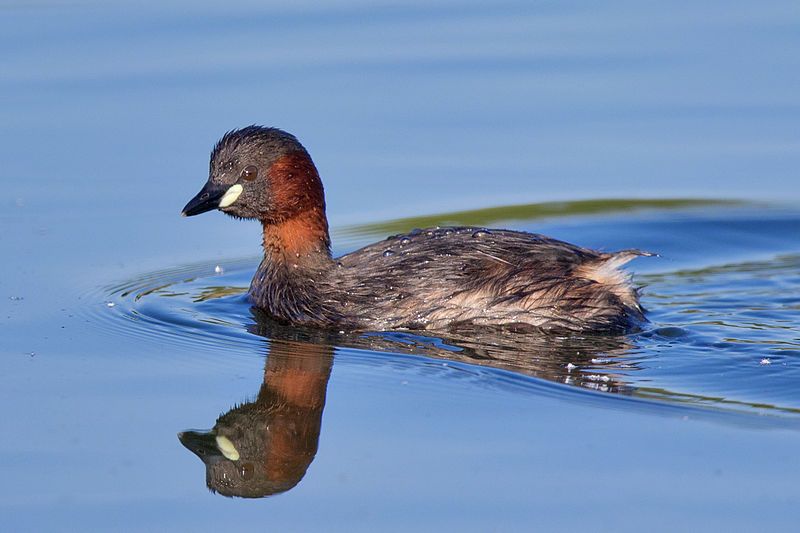
The little grebe, also known as the dabchick, is a type of water bird that belongs to the grebe family. Its genus name is derived from the Ancient Greek words “takhus” and “bapto,” which translates to “fast” and “to sink under,” respectively.
The species name, ruficollis, comes from two Latin words, “rufus” meaning “red” and “collum” which translates to “neck”. This is combined with the Modern Latin suffix “-Collis,” which translates to “-necked.”
Therefore, the species name of the little grebe indicates its neck being red.
| Kingdom | Animalia |
| Phylum | Chordata |
| Class | Aves |
| Order | Podicipediformes |
| Family | Podicipedidae |
| Genus | Tachybaptus |
| Species | T. ruficollis |
2. Cuculus Canorus
The common cuckoo is a part of the Cuculiformes bird family, a diverse group including roadrunners, anis, and coucals. This species is a migratory bird that moves between different locations based on the season.
The common cuckoo can be found in Europe and Asia during the summer months, but it will travel to Africa for the winter. This behavior is a part of the cuckoo’s natural life cycle that allows it to take advantage of the different climates in different regions.
This migration also helps the species find food and shelter in areas with scarce resources. The common cuckoo is an essential species in its natural environment, and its migratory behavior allows it to survive and thrive.
| Kingdom | Animalia |
| Phylum | Chordata |
| Class | Aves |
| Order | Cuculiformes |
| Family | Cuculidae |
| Genus | Cuculus |
| Species | C. canorus |
3. Blue Quail
The blue quail, or African blue quail, is a small bird that belongs to the Phasianidae family. It is found in sub-Saharan Africa, where it prefers dry grasslands and savannahs.
These birds are often seen in flocks of up to twenty birds, feeding mainly on seeds and grains. They are primarily active during the day and rest at night. The blue quail has a distinct appearance: a long neck and tail and a glossy blue-gray plumage.
Its head and neck are grayish-brown, while its chest and back are light blue-gray. It has a white rump, and its bill is yellowish-gray. Its legs are a reddish-brown color. The blue quail is a vital game bird in many parts of Africa, and it is hunted for sport and food.
It is also an essential part of the local culture and folklore.
It is believed to symbolize fertility and is sometimes used in traditional ceremonies and rituals. The blue quail is listed as Least Concern on the IUCN Red List, meaning it is not currently threatened with extinction.
However, it is still vulnerable to habitat loss and hunting, so protecting its habitats and regulating hunting is essential to ensure its continued survival.
| Kingdom | Animalia |
| Phylum | Chordata |
| Class | Aves |
| Order | Galliformes |
| Family | Phasianidae |
| Genus | Synoicus |
| Species | S. adansonii |
4. Pennant-winged Nightjar
The Pennant-winged Nightjar is a species of nightjar found in Nigeria and northern South Africa. This nightjar species is an intra-African migrant, meaning it migrates within the continent of Africa and is not found in other parts of the world.
During the breeding season, the Pennant-winged Nightjar displays remarkable sexual dimorphism. This means that the male and female of the species look markedly different from one another, usually in terms of the size and color of their plumage.
For example, the male might have brighter colors than the female, while the female might be more significant. This type of sexual dimorphism is seen quite commonly in the bird kingdom.
| Kingdom | Animalia |
| Phylum | Chordata |
| Class | Aves |
| Clade | Strisores |
| Order | Caprimulgiformes |
| Family | Caprimulgidae |
| Genus | Caprimulgus |
| Species | C. vexillarius |
5. Rail
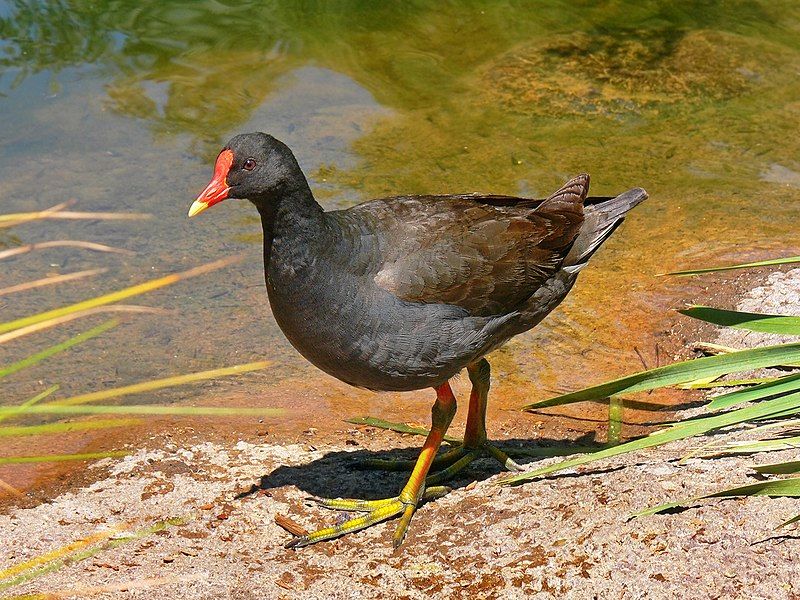
Rails are a large family of birds that vary widely in size and shape. They inhabit terrestrial and semi-aquatic habitats and can range from small to medium. The family is quite diverse, with species in many parts of the world.
The most common species include the crakes, coots, and gallinule. Other rail species, however, are much rarer and even endangered in some cases.
Due to their wide range of habitats, rails can be found in various climates and regions, from forests and wetlands to grasslands and coasts.
They typically feed on small invertebrates, such as insects, worms, and snails, but can also take advantage of larger prey when available. In addition, many rail species use their long bills to probe mud and shallow water for food.
Furthermore, rails have a unique form of courtship behavior, with males often displaying their colorful feathers and making loud calls to attract mates. All in all, rails are an incredibly diverse family of birds that play an essential role in the global ecosystem.
| Kingdom | Animalia |
| Phylum | Chordata |
| Class | Aves |
| Order | Gruiformes |
| Family | Rallidae |
6. Speckled Pigeon
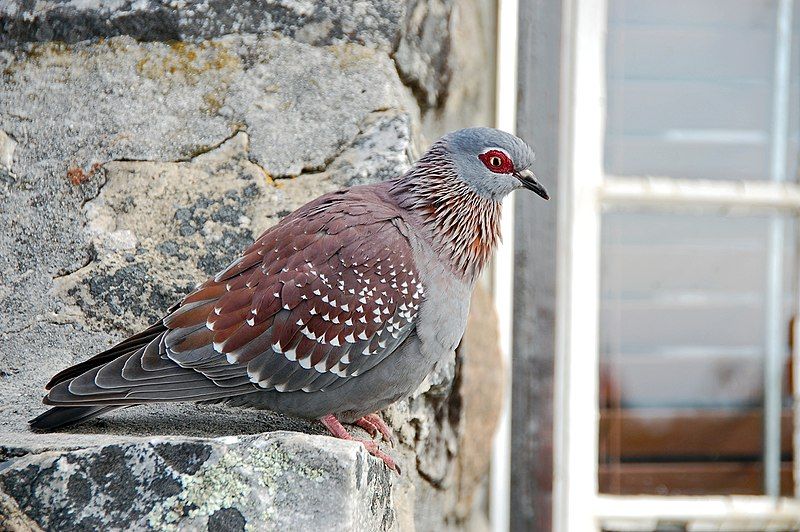
The speckled pigeon is a species of pigeon native to much of Africa south of the Sahara. It is a widespread bird found in many different kinds of open habitats.
It is widespread and found in many places in Africa, although there are some areas where it is not present. The speckled pigeon has other common names, such as African rock and Guinea.
It is a resident breeding bird in Africa, meaning it lives and breeds in Africa all year round. It is a hardy species and is known to survive in a variety of habitats and climates. The speckled pigeon can be identified by its speckled feathers.
The feathers are usually white or gray with black or brown spots. The pigeon is known for its large, broad wings and short, stout beak. The speckled pigeon is an important species for several reasons.
It is an important seed disperser, as it eats and disperses various seeds over a wide area. It is also a food source for many predators, such as hawks and eagles.
Additionally, it is valued as a game bird and is hunted in some areas. The speckled pigeon is an essential African species and an integral part of the African ecosystem.
It is a widespread species, although there are some areas where it is not present.
| Kingdom | Animalia |
| Phylum | Chordata |
| Class | Aves |
| Order | Columbiformes |
| Family | Columbidae |
| Genus | Columba |
| Species | C. guinea |
7. Ferruginous Duck
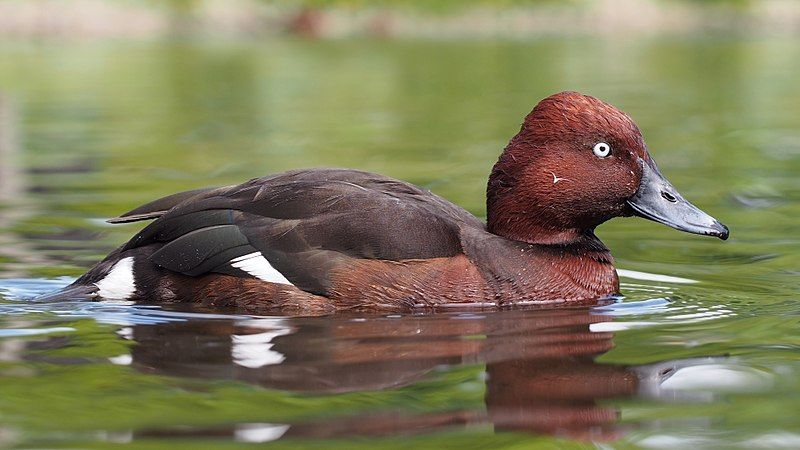
The ferruginous duck is a species of diving duck from the Eurosiberian region. It is also known by other common names such as ferruginous, common white-eye, and white-eyed pochard. Its scientific name is derived from two Greek words.
The first word, Lithuania, is an unidentified seabird mentioned by ancient writers such as Hesychius and Aristotle. The second word, nyrok, is the Russian name for a duck. This medium-sized duck species can be found in wetland habitats throughout the Eurosiberian region.
They are a migratory species whose populations have declined recently due to habitat destruction and hunting. The ferruginous duck has a distinctive rusty-brown coloration, which is why it is named after the Latin word for iron, ferruginous.
They feed on aquatic plants, insects, larvae, and small fish. The ferruginous duck is an essential part of the Eurosiberian ecosystem and is popular among birdwatchers.
Conservation efforts are underway to help protect the species from further decline and to ensure its continued survival in its natural habitat.
| Kingdom | Animalia |
| Phylum | Chordata |
| Class | Aves |
| Order | Anseriformes |
| Family | Anatidae |
| Genus | Aythya |
| Species | A. nyroca |
8. European Turtle Dove
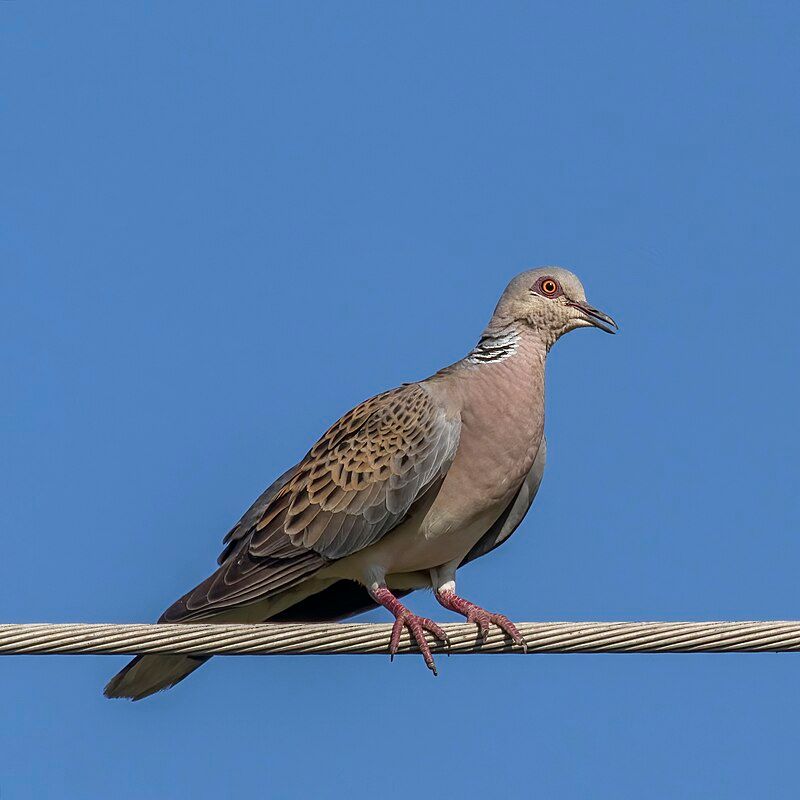
The European turtle dove is a species of bird belonging to the Columbidae family, including doves and pigeons. It is widely distributed across the southwestern Palearctic region, including North Africa.
During the winter, the turtle dove migrates to northern sub-Saharan Africa, likely seeking better climate conditions or more plentiful food sources.
This species is part of a larger migration pattern seen in many birds, which often travel long distances to more suitable habitats during the winter.
While the turtle dove’s migratory journey is relatively short, its ability to move between different regions is essential for survival—this bird species can survive in various environments, which helps it to survive in the face of changing conditions.
| Kingdom | Animalia |
| Phylum | Chordata |
| Class | Aves |
| Order | Columbiformes |
| Family | Columbidae |
| Genus | Streptopelia |
| Species | S. turtur |
9. Great Cormorant
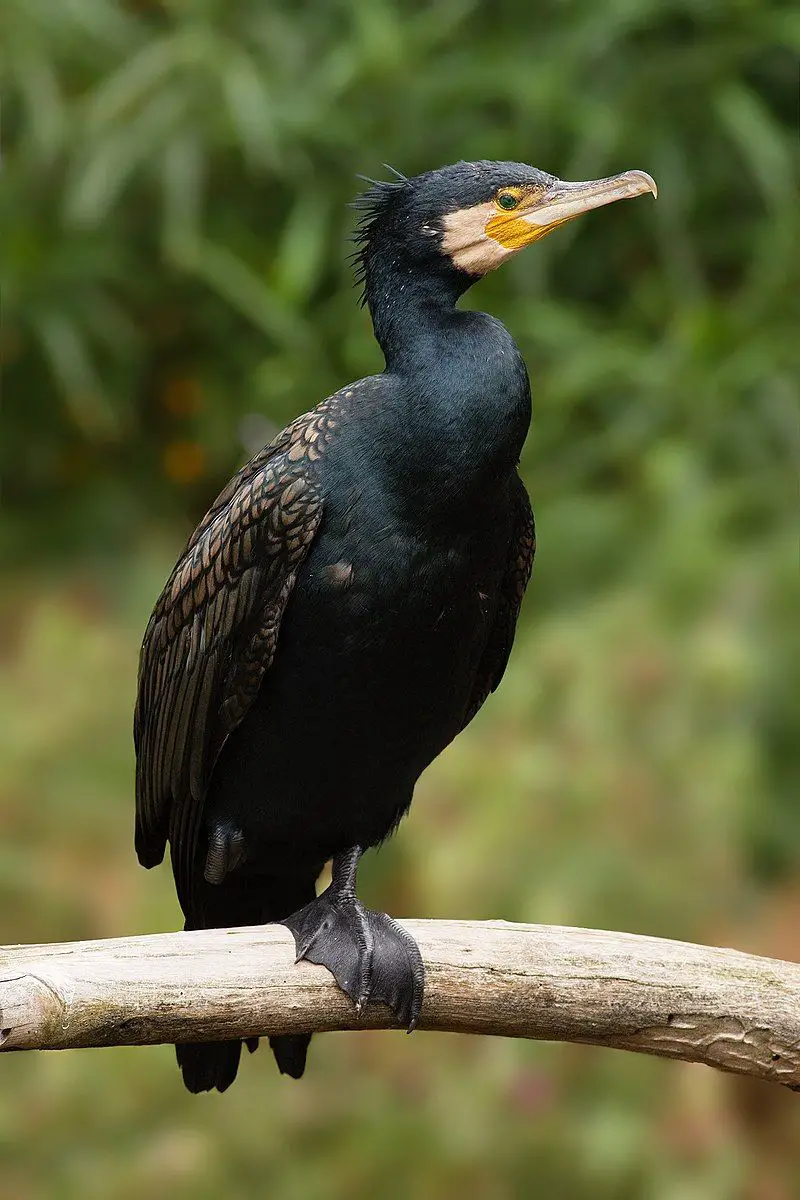
The great cormorant, also known by various other names, is a prevalent species of seabird belonging to the cormorant family.
In New Zealand, it is commonly referred to as the black shag or kawau, while across the Northern Hemisphere, it is known as the great black cormorant. In Australia, it is known as the black cormorant; in India, it is commonly called the large cormorant.
This bird species is found in many different areas worldwide, including temperate and tropical regions. The great cormorant has a long, slender body with a wingspan of 2.3 to 3.9 feet.
Its body has a blackish-brown plumage, while its head and neck are usually white. This species is a strong swimmer and an adept angler, and it is most frequently seen diving into the water to catch its prey.
It feeds mainly on small fish but also eats crustaceans, mollusks, and sometimes aquatic insects. The great cormorant is a pretty social species, and it can often be seen in large groups near the coast.
These birds will often nest together in large colonies and usually share nesting sites.
They also have a wide variety of vocalizations to communicate with one another. Overall, the great cormorant is an impressive species of seabird, and it is found in many different parts of the world.
Despite its many different names, this species is easily recognizable, and its unique plumage and vocalizations make it easy to identify.
| Kingdom | Animalia |
| Phylum | Chordata |
| Class | Aves |
| Order | Suliformes |
| Family | Phalacrocoracidae |
| Genus | Phalacrocorax |
| Species | P. carbo |
10. African Collared Dove
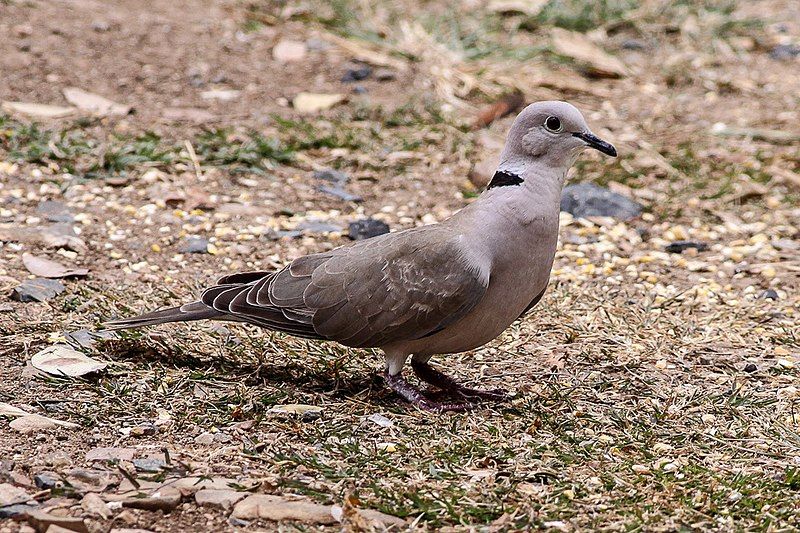
The African collared dove is a small bird found in the Sahel in northeast Africa and southwestern Arabia. This bird has adapted to its arid environment and is often spotted around water sources, as it is essential for its survival.
In terms of size, the African-collared dove is typically around 26 cm in length. This makes it one of the smaller birds in the dove family, although it is still easily identifiable due to its light brown color and black and white collar-like markings on its neck.
| Kingdom | Animalia |
| Phylum | Chordata |
| Class | Aves |
| Order | Columbiformes |
| Family | Columbidae |
| Genus | Streptopelia |
| Species | S. roseogrisea |
11. Black-bellied Bustard
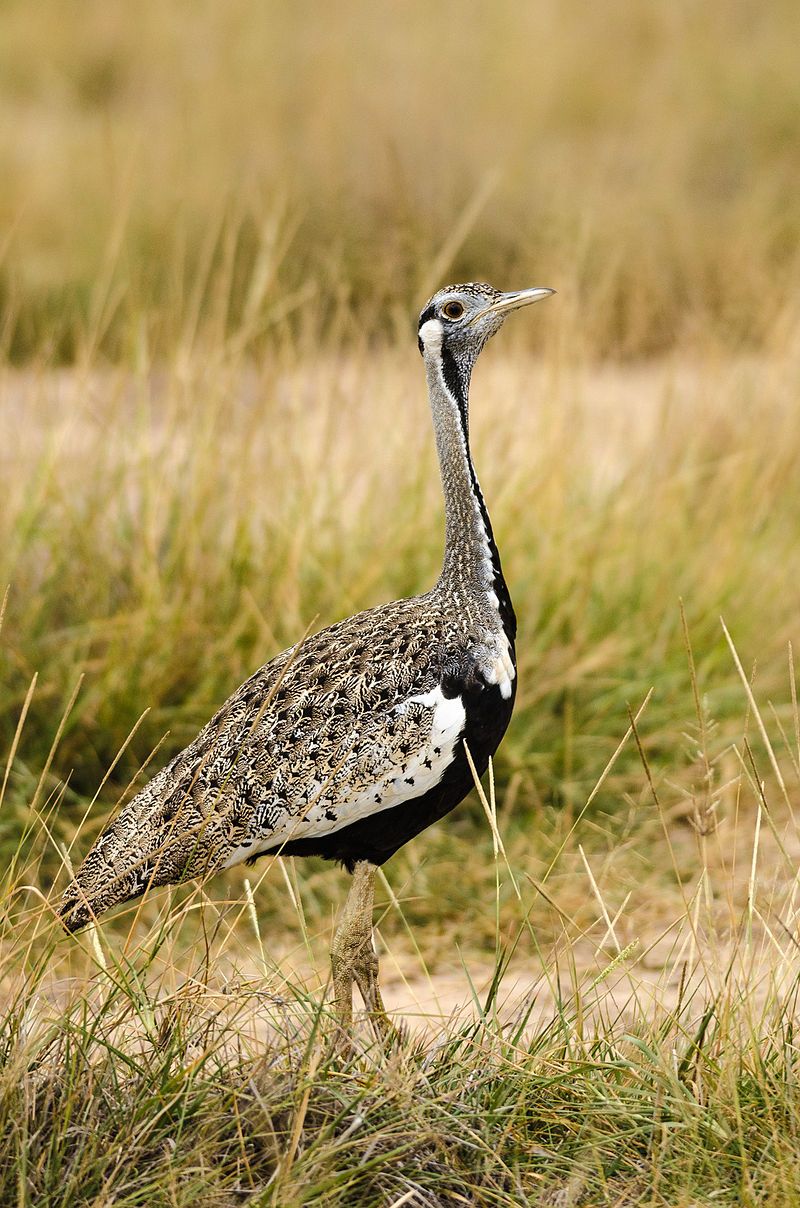
The black-bellied bustard, also known as the black-bellied korhaan, is a species of large bird that is native to Africa. It is a member of the bustard family, comprised of large ground-dwelling birds found in Africa, southern Europe, and parts of Asia.
The black-bellied bustard is characterized by its black-colored belly and legs, as well as its brownish-gray wings and head.
It is a rather large bird, with an average body length of around 70 cm and a wingspan of roughly 120 cm. The black-bellied bustard lives in open grasslands and savannas, feeding on various insects, lizards, and small mammals.
It is a solitary bird that occasionally forms small flocks for food.
In the breeding season, the male black-bellied bustard performs a distinctive courtship display, including raising its wings and neck feathers, fanning its tail, and making loud calls.
The female will lay a clutch of one to five eggs, which are incubated for about a month before hatching. The International Union for Conservation of Nature (IUCN) considers the black-bellied bustard a species of most minor Concern.
Although its population is decreasing in some areas due to habitat loss, it is still found in large numbers in other parts of Africa.
| Kingdom | Animalia |
| Phylum | Chordata |
| Class | Aves |
| Order | Otidiformes |
| Family | Otididae |
| Genus | Lissotis |
| Species | L. melanogaster |
12. Common Ostrich
The common ostrich is one of the most giant living birds in the world, standing up to 8 feet tall and weighing up to 250 pounds. It is flightless, meaning it cannot fly.
It is native to some areas of Africa but is found in many other places worldwide due to its popularity as a domesticated bird. The common ostrich is a member of the ratite order of birds and other flightless birds like the emu and kiwi.
It is one of only two species of ostriches, both of which belong to the genus Struthio. Ostriches are well known for their long necks and powerful legs, which they use to run up to 45 miles an hour.
They also have a unique ability to store fat in their bodies, which helps them survive prolonged droughts. Ostriches are omnivorous, meaning they eat both plants and animals.
They are mostly ground-dwelling birds, but they are also capable of swimming and are known to use their wings to help keep balance while running.
| Kingdom | Animalia |
| Phylum | Chordata |
| Class | Aves |
| Order | Struthioniformes |
| Family | Struthionidae |
| Genus | Struthio |
| Species | S. camelus |
13. White-spotted Flufftail
The white-spotted flufftail is a unique bird species belonging to the family Sarothruridae. It is found in many tropical rainforests throughout Africa and has a wide range of presence across the continent.
This bird species is identified by its white spots on its plumage, making it stand out amongst its surroundings. The flufftail also has a distinct call that can be heard in the African rainforest, making it easier to spot.
Its diet consists mainly of insects, fruit, and other small animals, which it can easily find in its tropical environment. This bird species is known for its shy nature and is usually found in small groups, although they can sometimes be seen alone.
The white-spotted flufftail is an integral part of the African rainforest ecosystem, and its presence is essential for the ecosystem’s health.
| Kingdom | Animalia |
| Phylum | Chordata |
| Class | Aves |
| Order | Gruiformes |
| Family | Sarothruridae |
| Genus | Sarothrura |
| Species | S. pulchra |
14. Yellow-billed Stork
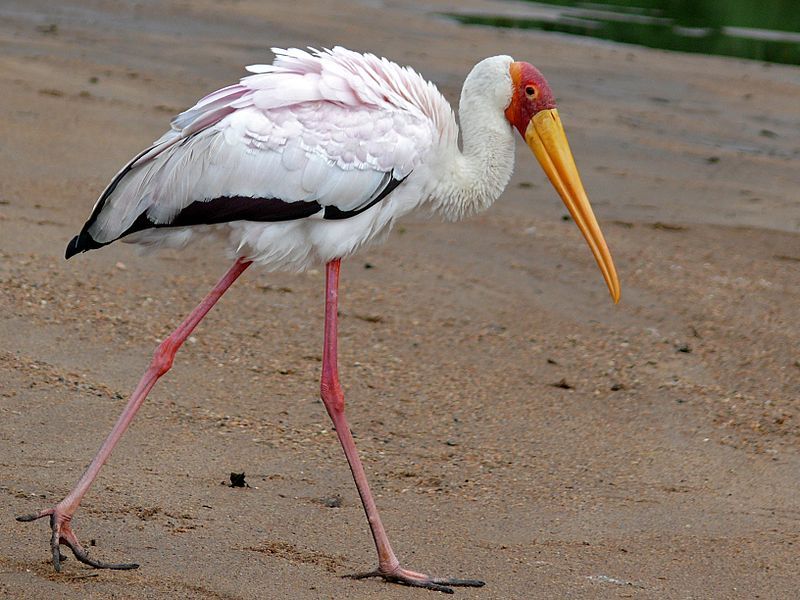
The yellow-billed stork is a large bird species found in Africa, south of the Sahara Desert. Other names, such as the wood stork and wood ibis, also know it. The yellow-billed stork belongs to the family Ciconiidae, a group of wading birds.
The species is widespread in the African continent but is also found in Madagascar. The yellow-billed stork is a large bird with a wingspan of up to 2.5 meters. Its body is mainly white, and its head is grey with yellow beaks and legs.
It has a distinctive black stripe on the top of its neck. These birds feed on small fish, frogs, insects, and other animals. They wade through shallow waters while hunting for food.
The yellow-billed stork is a highly social species and can often be seen in flocks of up to dozens of birds. They nest in colonies, usually near wetlands and rivers.
The breeding season for these birds is during the summer; during this time, they can be heard making loud, guttural noises. The young birds are born blind and are fed by their parents until they can fend for themselves.
The yellow-billed stork is an essential species of the African ecosystem. It helps keep insects, amphibians, and small mammals in check and is also a popular species for birdwatchers. Unfortunately, these birds are increasingly threatened by habitat destruction and pollution.
Conservation efforts must be made to ensure the survival of this iconic species.
| Kingdom | Animalia |
| Phylum | Chordata |
| Class | Aves |
| Order | Ciconiiformes |
| Family | Ciconiidae |
| Genus | Mycteria |
| Species | M. ibis |
15. Greater Painted-snipe
The greater painted-snipe is a type of wading bird found in the family Rostratulidae. It is primarily found in Africa, South Asia, and Southeast Asia marshy areas. This bird species has a unique appearance, with a long bill, bright colors, and a plump body.
Its head and neck have a reddish-brown hue, and its back and wings are marked with black and white stripes. The greater painted snipe is a shy bird that typically hides in thick vegetation and is usually seen in the mornings and evenings.
It feeds on insects, worms, and other small invertebrates that it finds in the mud or shallow waters. The greater painted snipe is an integral part of the ecosystem as it helps balance the population of small invertebrates.
Unfortunately, this species is threatened by habitat loss, pollution, and hunting. Conservation efforts are needed to ensure that the greater painted snipe will continue to thrive in its natural habitat.
| Kingdom | Animalia |
| Phylum | Chordata |
| Class | Aves |
| Order | Charadriiformes |
| Family | Rostratulidae |
| Genus | Rostratula |
| Species | R. benghalensis |
Conclusion
Birds play an essential role in the ecosystem of Rijau. They provide various environmental services, such as pollination, seed dispersal, pest control, and food for other animals.
They also provide a source of enjoyment for people, as they are often seen in the wild and parks. Birds are essential to the health of Rijau and should be protected and conserved.